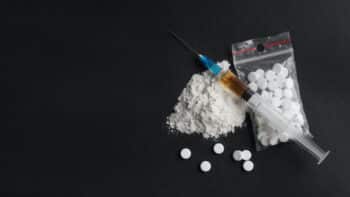Fentanyl And Xylazine

Xylazine Mixed With Fentanyl (FAAX)
Fentanyl-adulterated or -associated Xylazine (FAAX) is the colloquial term for a dangerous combination of Fentanyl, a powerful synthetic Opioid, and Xylazine, a veterinary sedative. This mixture has grown in prevalence and poses a severe threat to those consuming it, often unknowingly.
What Is Xylazine?
Xylazine is a non-Opioid sedative, analgesic, and muscle relaxant primarily used in veterinary medicine for the sedation of animals. It acts by depressing the central nervous system. Due to its effects and accessibility, it has found its way into illicit drug markets and is often mixed with Opioids, especially Fentanyl.
Why Is Xylazine Mixed With Fentanyl?
Mixing Fentanyl with other drugs stems from the push to maximize profits, intensify effects, and mask impurities.
When it comes to mixing Xylazine with Fentanyl, there are several reasons, including:
- Cost: Xylazine is relatively inexpensive compared to many other substances. By using it as a filler or cutting agent, the supply of Fentanyl can be stretched, thereby maximizing profitability.
- Enhanced Potency Perception: By combining the two drugs, a person might experience intensified euphoric and sedative effects. This heightened effect can be misinterpreted as a sign of a “better” or more potent product. As a result, people may be drawn to a particular batch, believing it offers a stronger experience.
- Availability And Accessibility: Xylazine may be more accessible in certain contexts than other potential cutting agents. This accessibility makes it an attractive option for those looking to adulterate their Fentanyl supply.
- Mimicking Or Extending Effects: Fentanyl is known for its powerful and rapid onset of effects. Xylazine, with its sedative properties, can extend or mimic some of the desired effects of Opioids, making the combination appear more appealing.
- Masking Impurities: In the illicit drug trade, cutting agents like Xylazine can sometimes be used to mask impurities or other adulterants in the drug mixture, creating the illusion of a cleaner product.
However, the grave risk lies in the fact that many people who use drugs are unaware of the exact substances they are consuming.
Fentanyl And Xylazine Effects
Fentanyl on its own is already 50-100 times more potent than Morphine. When Fentanyl is combined with Xylazine (a substance not meant for human consumption), the effects can be devastating and potentially lethal.
The dangerous synergy of these two drugs manifests in a range of physical side effects. Some of the notable side effects include:
- Extreme Sedation: Extreme sedation can lead to unconsciousness, putting people at risk of various complications, including choking or injury.
- Respiratory Depression: A reduced breathing rate can be fatal, as it may deprive the body of essential oxygen.
- Low Blood Pressure (Hypotension): Low blood pressure can result in dizziness, blurred vision, or even fainting.
- Slow Heart Rate (Bradycardia): A significantly reduced heart rate can compromise blood flow to vital organs.
- Organ Damage: Chronic use of FAAX, particularly when overdose occurs, can lead to damage of vital organs due to hypoxia or an inadequate oxygen supply.
It’s crucial to understand that Fentanyl on its own already presents significant risks. The addition of Xylazine only magnifies these dangers.
Xylazine-Related Wounds
One of the more alarming repercussions of Xylazine misuse is the development of severe and painful skin ulcers or wounds, often at the injection site. These wounds, beyond being visually concerning, can lead to deeper medical issues, including:
Necrotic Tissue Formation
Xylazine can cause the tissues around the injection site to die, leading to the development of necrotic ulcers. These ulcers are not just painful; they can lead to significant tissue loss and expose deeper tissues to external contaminants.
Infections
Open wounds, especially necrotic ones, are highly susceptible to bacterial infections. If left untreated, these infections can spread to surrounding tissues and even enter the bloodstream, potentially leading to sepsis, a life-threatening condition.
Scarring
Even after healing, Xylazine-related wounds can leave behind significant scars, which might result in long-term cosmetic and functional issues, depending on their location and severity.
Delayed Wound Healing
Xylazine can impede the body’s natural wound healing processes. As a result, these wounds may take longer to heal, increasing the duration of pain and risk of complications.
Potential For Amputation
In extreme cases, where the wounds are profoundly deep, have become severely infected, or where significant necrotic tissue is present, medical intervention might require amputation of the affected limb or extremity.
It’s vital to understand that these wounds are not just superficial injuries but can lead to profound long-term health consequences. Immediate medical attention and intervention are critical for anyone displaying such symptoms after suspected Xylazine usage.
Xylazine And Fentanyl Overdose
Due to the potent combination of these drugs, the risk of overdose is considerably heightened. Symptoms can include difficulty breathing, extreme drowsiness, inability to wake up, cold and clammy skin, and blue-colored lips or nails.
Immediate medical attention is crucial for anyone suspected of overdosing on this mixture.
Naloxone Does Not Treat Side-Effects Of Xylazine
While Naloxone is an effective antidote for Opioid overdoses, including Fentanyl, it does not counteract the effects of Xylazine.
This potential overlap of symptoms can lead to diagnostic challenges, as first responders or medical personnel might first interpret the symptoms as an indication that additional doses of Naloxone are required. In reality, the individual is grappling with the aftermath of Xylazine exposure, necessitating a different treatment approach.
One of the significant risks associated with Xylazine is its potential to depress the respiratory system, a threat that Naloxone cannot address. As a result, even after Naloxone administration, the threat of respiratory complications remains.
Get Help For A Fentanyl Addiction
If you or a loved one is struggling with an Opioid addiction, particularly involving substances like Fentanyl, seeking treatment is imperative.
Don’t wait for the situation to escalate. Contact a treatment provider today and take the first step towards recovery.